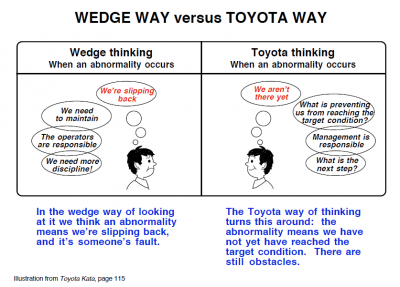TWI Job Instruction is a structured process for breaking a job or task into teachable elements, and a 4 step process for teaching that job to someone.
I am not going to try to explain everything about breaking down a job here, this post is primarily for people who use job breakdowns and job instruction already.
The process of breaking down a job involves:
- Identifying the Important Steps – the sub-tasks that materially advance the work.
- Then identifying Key Points within important steps. These are things which the team member must pay special attention to, or perform a specific way. The guideline is that a key point is something which:
- Is a safety issue – could injure the worker, or someone else.
- Would “make or break the job” – critical to quality or the outcome of the work.
- Is a “knack” or special technique that an experienced team member would use to make the job easier to do.
Breaking down a job this way takes practice, but it is a great way to identify the elements that are critical to safely getting a quality job done, and ensuring that the team member understands them.
But I want to propose this is only the first step.
Every key point is something the team member must remember in order to to not get hurt (or hurt others); to avoid scrapping or damaging something; to perform at the level you need.
Take it to the next level.
Think of these key points and the training that they drive as temporary countermeasures. They are stop gaps you have in place until you can do something more robust.
Take one key point at a time. Why is it necessary? Why is it possible to do this step any way but the best way?
Can you alter the work environment – the product, the process, the equipment, the visual controls to reduce the things the team member has to remember (and you have to remember to teach)?
Can you make it impossible to perform that step in any way other than the way it should be done?
If you can’t, can you make it impossible to proceed until the error is corrected, before any harm is done?
If you can’t, can you make it so obvious that it is impossible to miss?
If you can’t, can you put in a robust reminder? (Signs and placards generally DON’T WORK for this unless they are especially “sticky.”
Every key point is something you have identified as critical to doing the job directly. Therefore every key point should drive a focused effort to mistake-proof the work.
You want to have as few as possible… but no fewer.



